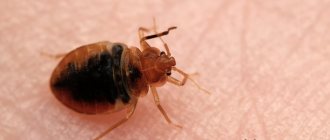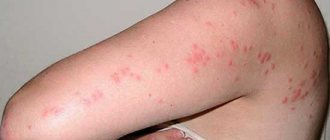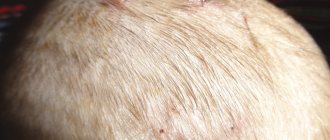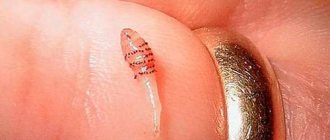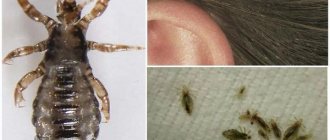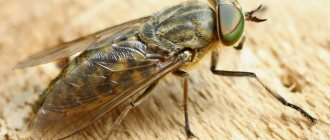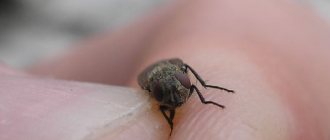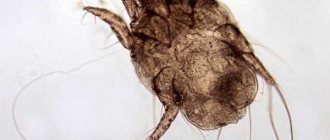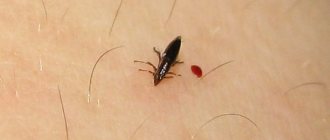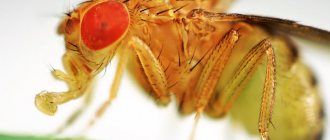Among over 150 species of gadflies, only one is dangerous to humans, called Dermatobia Hominis. It cannot be found in Russia and the CIS countries - the insect is found only in countries with a tropical climate: Central America, Argentina and some areas of Mexico. A gadfly larva in a person can cause a lot of unpleasant phenomena: inflammation, suppuration, disruption of the normal functioning of body systems, and surgical intervention may be required to remove it.
What do a gadfly and its larvae look like?
Gadflies live in almost every corner of the planet; in total there are more than 150 species of insects. In our country, 60 varieties are registered. Usually, gadflies lay their larvae in the body of animals, less often they get under the skin of a person. Dermatobia Hominis - the “human gadfly” lives in the tropics (Mexico, South America, Argentina). In the temperate climate of Russia, Ukraine and the countries of the former USSR, the insect has not been observed.
The adult is a special species of fly measuring up to 20 mm. Dermatobia Hominis looks like a small bumblebee: a shaggy body and a bright orange color. The gadfly has a rather large head with pronounced large eyes, a blue abdomen, and small transparent wings.
Insects living in our latitudes usually have a calmer color: dark brown or coal-black, gray-blue. They prefer livestock as a host, but it happens that when they bite, they also infect humans.
The adult does not feed; the supply of nutrients obtained during the larval development stage is enough for the entire life cycle.
The larva after birth is very small. During the phase, it grows several times, reaching 2 cm. Its body has an oblong teardrop shape. Special hook hairs allow it to attach to the skin of animals or humans.
One adult female can reproduce up to 650 eggs, but only 20% are viable.
A species of dangerous gadfly that lives in southern countries.
Procedure after a gadfly bite
Direct treatment of a gadfly bite is preceded by first aid. Without it, the consequences are much stronger, and their elimination is longer and more labor-intensive.
First aid
- Pressing down.
Immediately after the gadfly bites, press down on its place with any hard object at hand or pinch the skin with a pinching movement of your fingers. This will prevent the rapid spread of allergic contents and reduce pain.
- Cold.
Cold water, any metal object, ice and other cool surfaces will do. The purpose of this effect is similar to pressing - to reduce swelling from a gadfly bite, pain, and itching.
- Soap.
If you have it on hand, it is good to apply a soap compress to the bitten area. Any toilet or laundry soap is suitable for this. Lather it on a damp cloth and apply it to the bitten area. If it is not available, you can generously soap the area where the gadfly has bitten.
- Antiseptic.
How to anoint a gadfly bite? We recommend that you avoid products with a burning and very drying effect. It is best to use a solution of Rivanol 0.1%. Its bottle will not take up much space in your medicine cabinet or purse and will be useful in a variety of situations. Simply wipe the bitten area with a cotton swab or cloth soaked in it.
Carefully! The yellow solution of Rivanol leaves marks on fabric and skin. But this is its only drawback.
IMPORTANT: “Consultation with a physician is required before use”
Gadfly bites usually occur unexpectedly, and most often you have to use improvised means. As first aid in the absence of other means, the juice of a crushed plantain leaf or dandelion stem, chopped onions, a salt or soda solution, and vodka lotions will help. But, these are only first aid measures if it is impossible to use Rivanol.
The above recommendations will help you avoid the rapid growth of swelling from a gadfly bite, prevent secondary infection, and relieve itching and pain. If swelling and/or redness grows beyond 7 cm in diameter, you should definitely consult a doctor.
How does a gadfly larva enter the human body?
The gadfly larva can enter the human body in several ways:
- The female lays eggs on the abdomen of blood-sucking insects (mosquitoes, ticks). When a person is bitten by intermediary insects, the eggs land on the person's body. When warmed up, they burst and larvae emerge from them, which get under the skin. The introduction of parasites is practically not noticeable.
- When a human is bitten directly by the female gadfly itself, the larvae enter the wound, after which they fully develop as parasites in the person.
- Hypodermatosis is a disease associated with these parasites. In this case, the larva is acquired tactilely from cattle. It is the countryside and farms in our latitudes that can be considered a potential site of infection. Parasites get under the skin, and they can move along the body, leaving characteristic traces. The larvae usually penetrate the body in areas where the skin is more delicate, for example, on the head, arms and legs, abdomen, neck, and less often they can concentrate on the lips and in the eye.
- Eggs and larvae can also enter internal organs. This occurs when eating animal meat contaminated with gadfly. The gastric parasite is much more dangerous than the subcutaneous larva of the gadfly, since its parasitism can lead to serious disruptions in the functioning of the body.
More complex forms may also occur, when there are several larvae in different areas of the human body.
Prevention of infection
To avoid infection by larvae, caution is required when traveling, particularly to tropical countries. It is recommended to adhere to the following rules:
- wear clothes that cover the body as much as possible;
- use repellents;
- when the bite has already occurred, it needs to be treated with an antiseptic;
- If you feel unwell, you should consult a doctor.
Numerous larvae can provoke a variety of consequences, for example:
- allergies;
- purulent infection;
- meningitis, pneumocephalus, ulcer;
- erosion of the nose or eyes.
Important! Having seen redness of the skin, which looks like a bite, you need to determine whether it is affected by a gadfly, in particular, while staying in tropical countries. One of the effective methods of counteracting dermatobiasis is the destruction of flies, mosquitoes and other insects in the house.
Stages of larval development
The larval stage of the gadfly usually lasts 6-10 weeks. After entering the host’s body, the parasite begins to intensively feed on blood, drawing out useful substances. In a few weeks it increases in size tens of times, and the mature larva reaches 2 cm.
The photo shows a small gadfly larva extracted from a human body.
Having collected the necessary supply of nutrients from the host, the parasite breaks through the skin and crawls out. After this, a new stage of development of the gadfly begins - the pupa. In this phase, the insect arrives for 2-4 weeks, after which it turns into an adult, the life cycle of which is 20 days, the main task of the fly is reproduction.
Consequences
Infection with the subcutaneous botfly leads to the following consequences:
- Cows have a decrease in milk yield by approximately 7%.
- Young animals have growth retardation.
- For the leather industry - the skin of animals that have suffered from hypodermatosis has holes, which spoils the raw hides.
- For the meat industry, the capsules in which the larvae developed require removal, due to which a fairly large amount of meat is lost; sometimes, with severe contamination, about 10% of the raw materials have to be cut out.
If signs of infection are detected, animals are slaughtered exclusively in sanitary slaughterhouses.
Symptoms of the appearance of gadfly larvae in humans
Parasites penetrate into any part of the body, their penetration at the initial stage is not noticeable at all. After 1-2 weeks, the site of penetration swells, turns red, and looks like a mosquito bite.
After another couple of weeks, the skin becomes blue, swelling appears with suppuration in the center, like the stem of an acne. The abscess bursts and the open wound allows the parasite to gain access to air.
The general health of a person infected with gadfly larvae worsens: nausea and dizziness, weakness, fever, and burning in the affected area appear.
If the larva is in the eye, tearing, redness, increased eye pressure, and less often bleeding are observed.
Less commonly, a focus of development is observed in the nasal cavity, as evidenced by pain, headaches, and swelling.
Classification of disease types and signs of invasion
Depending on which tissues or organs are affected, myiases are divided into:
- subcutaneous;
- intestinal;
- genitourinary;
- ophthalmic;
- nasal;
- oral;
- ear
Each form has its own symptoms. What is common is a deterioration in well-being. A person experiences itching and pain at the site of penetration of the larva. Weakness, nausea, dizziness, and headache appear. Possible increase in temperature and fever.
Subcutaneous
The fly does not lay larvae under the skin, since the ovipositor is not capable of damaging the skin. The laying is done either on the surface of the skin or in existing damage. The hatched larvae independently penetrate the epidermal layer. This is how subcutaneous myiasis develops. The main symptoms are red-purple blisters on the skin (sometimes with a hole in the center). When the larvae move, the victim experiences pain and itching. Parasites can be located shallowly, in the upper layer of the skin, or penetrate deeper into the connective tissues and further into the muscles and tendons.
Intestinal or cavitary
Intestinal myiasis can be caused by almost any type of insect, even ordinary house flies. The larvae enter the human body through the gastrointestinal tract along with food. Most often, the larva dies after a few days and is excreted in feces or vomit. But sometimes (most often with low acidity) the larvae begin to develop in the intestine, penetrating its mucous membrane.
Symptoms of intestinal myiasis:
- pain in the abdomen and anus;
- nausea, vomiting;
- diarrhea;
- weight loss.
In the advanced stage, internal bleeding appears.
Urogenital
This type of myiasis appears due to the fact that fly larvae penetrate the urethra. Most often this happens after a person puts on underwear, on the surface of which the female has laid eggs. After the parasites penetrate the human body, their vital activity becomes the cause of inflammatory processes in the genitals or bladder. A common symptom is difficulty urinating, pain in the urinary canal.
Ophthalmic
Ophthalmomyasis is one of the most severe types of disease. It occurs after fly eggs or larvae enter a person's eye. Parasites penetrate into the thickness of the conjunctiva, into the mucous membrane, or even into the eyeball. This leads to pain, decreased visual acuity, and in advanced cases can cause complete blindness.
Nasal or nasal
This form of myiasis is quite rare in humans. Most often, wild animals become infected with it. In most cases, the cause of the disease is nasopharyngeal gadfly. These viviparous insects seem to inject larvae into the nostrils or eyes of the victim. The larvae invade the nasal mucosa, and then can move further and even reach the brain. Symptoms of infection:
- pain in the nose;
- increased secretion of mucus;
- frequent sneezing;
- purulent rhinitis.
As the parasites move inside the body, the location of the pain changes.
Oral
Cases where a fly has laid eggs or larvae in a person’s mouth are extremely rare. This is primarily due to the fact that foreign organisms in the oral cavity are very easy to detect. But if infection does occur, inflammation, ulcers, and fistulas appear in the mouth.
Ear shape
Otomiasis develops when a fly lays eggs inside the ear or on the surface of the auricle. You can also become infected if you sleep on linens that have eggs or larvae on them. The larvae hatching from laid eggs penetrate deep into the auricle, causing pain and hearing impairment. In severe cases, the parasites penetrate the brain.
What harm do gadfly larvae cause to humans?
Undoubtedly, gadfly larvae cause serious harm to the human body. The degree of impact directly depends on the location of the parasites. Skin larvae disrupt the general state of health, the functioning of organs, and poison the body with waste products.
The most dangerous are cavity parasites that concentrate in the internal organs: stomach, intestines, ENT organs.
Complete blindness is threatened by the larva of the gadfly, deposited in the human eye.
It is very important to eliminate the pest at an early stage of development to minimize complications.
Horseflies
Horseflies, unlike gadflies, are equipped with a fleshy proboscis, inside of which there are hard and sharp piercing and cutting blades. This is why the bite of a horsefly is so painful for both people and animals. The skin in this area remains thick and red for several days, and a slight temperature may rise.
Only females drink blood; males use plant juices for nutrition. Unfertilized females also drink flower nectars, but to lay eggs they only need blood and as much as possible. Cases have been recorded where, after being attacked by a dozen horseflies, a person ended up in intensive care and required a blood transfusion. In terms of the amount of blood taken, the bite of one horsefly on average is equal to the bites of almost 70 mosquitoes.
How to remove a botfly larva from under the skin?
Removal of the larva can be carried out in two ways:
- surgical;
- medicinal.
The main task of any method is the safe removal of the foreign body. The removal operation is performed under sterile conditions. The affected area is treated with an antiseptic (iodine, potassium permanganate). A drop of sterile oil will help block air access to the larva. Once in unfavorable conditions, it will begin to crawl out of the body on its own. The parasite is pulled out using tweezers or a special clamp.
The larva crawls out from under the skin in the leg.
After removal, the wound is treated and then bandaged with a sterile cloth.
The operation must be carried out by a specialist, since if you extract it yourself, parts of the parasite may remain under the skin, which will cause inflammation and suppuration of the wound.
The safest extraction is to allow the larva to leave the host’s body on its own. To do this, use ointments, creams and oils to remove parasites.
Extracted larva and skin damage.
A course of drug treatment will allow you to provoke the release of a foreign object, affecting it through its source of nutrition - blood. Such drugs contain substances that are toxic to the parasitic organism.
Establishing a diagnosis
If a person suspects he is infected, he should seek help from a good parasitologist or infectious disease specialist.
The doctor sends the patient for a blood test, which determines the amount of antibodies. The specialist undertakes to find out from his client whether he has been to African countries or other places where the terrible gadfly lives.
A visual inspection is required. If infection occurs, an abscess with a fairly large hole forms on the cover.
Inspection is carried out using a special magnifying glass.
Where to look for them?
In general, skin beetle larvae are very secretive insects. Unless absolutely necessary, they do not get out of their hiding places, do not crawl into open places and do not get noticed. The bulk of them spend almost their entire larval age in places where people not only don’t look, but where they can’t even get to.
For example, during processing we most often found skin beetle larvae in the following places:
- Gaps behind baseboards near kitchen tables
- Floors under the edges of linoleum under stoves, refrigerators and tables - food crumbs often roll in here
- Cabinets with things, especially wool and fur
- Closets and cabinets with forgotten food supplies
- Natural fabric bedding
- Sleeping places – beds and sofas
Litter on the floor with traces of feeding by carpet beetle larvae
It is very important to understand that the larvae that you notice somewhere in the open, actively crawling, are only individual individuals. The bulk of their counterparts are located somewhere where it is very difficult to look, and where they can only be found by moving furniture, dismantling the bed, or removing the baseboard. Therefore, you should not expect that by crushing several of these pests, you will get rid of all the skin beetles in the house.
On a note
But adult beetles can be found almost anywhere in the apartment. They actively fly and crawl in search of sexual partners and places for laying eggs, and on such wanderings they very often catch the eye. At each such meeting, the bugs must be destroyed so that at least these individuals do not reproduce in any way.
The weak point of all skin beetles
The “Achilles heel” of skin beetle larvae is their rather long development time.
For example, in carpet beetle larvae develop in 6 months under ideal conditions, up to 3 years in non-ideal conditions, and on average one and a half to two years. The larvae of the house leather beetle develop for a year and a half, while for the museum leather beetle it takes 10-11 months.
From left to right: an adult beetle, a discarded chitinous shell of a larva, a pupa and a last instar larva.
For comparison: bed bug nymphs go from hatching from an egg to sexual maturity in 4-5 weeks, and barn moth larvae (also called kitchen moths) in 1-2 months.
Because of such slow development, skin beetles do not have time to reproduce quickly enough anywhere, and therefore they are relatively easy to destroy. It is enough to kill the larvae and beetles in the places of the main accumulations, and then only finish off the individuals that accidentally catch your eye when you meet them in order to completely exterminate them indoors. They will not be able to quickly multiply, as happens with cockroaches, and restore their numbers.
But despite this, many people fail to completely get rid of skin beetles. The reasons for this are typical, but not always removable.
How dangerous are these insects?
The main danger of skin beetle larvae is their gluttony and indiscriminate eating. If in wild (or semi-wild) nature they feed mainly on the remains of dead animals - wool, dried and hardened meat, skins, skin, chitinous coverings of dead insects, feathers, sometimes even dry grass - then in apartments they look for substitutes for such food, and easily damaged:
- Fur
- Wool knitwear
- Leather shoes and clothes
- Carpets made of natural wool or cotton
- Various collections – herbariums, insect collections
- Skins
- Stuffed animals and birds
- Various animal products - cheeses, sausages, dried fish and meat, meat and bone meal, dog and cat food
- Cereals and groceries (by the way, they are not eaten by the larvae of all types of skin beetles)
This is, for example, what a fur coat looks like after encountering skin beetle larvae:
And it is clear that if, say, no one is particularly upset because of a kilogram of damaged cereal, then a chewed expensive fur coat, or good shoes with ugly furrows, is serious damage.
On a note
Skin beetle larvae can eat any tissue of the animal body, except bones. This is used in some museums: the remains of animals whose bones they want to preserve for collections are specially placed in a room where thousands of beetles and their larvae are located, and in a few days these voluntary cleaners “remove” absolutely everything from the bones, including ligaments, tendons and places muscle attachments. After their work, the bone will not rot or stink - there is simply nothing left that could rot.
Moreover, due to their small size, immediately after hatching from eggs, the larvae of skin beetles can get through the smallest cracks into boxes, for example, with collections of insects . Of course, doors to closets with fur coats and sweaters will definitely not stop them.
It is interesting that larvae can begin their destructive activity in an apartment, for example, in a sofa drawer, or behind a baseboard, where they will simply eat microscopic exfoliating pieces of skin, hair and the remains of cockroaches. And when they grow up and their appetites increase, they will already go in search of more abundant sources of food. And at this stage the larva is already dangerous for things: it can gnaw through a sweater, “shave” a stain on a fur coat, or make holes in the carpet. And when there are many such larvae, this danger increases many times over.
For example, in the photo there is litter damaged by larvae:
And here are slippers, forgotten under the sofa and found by hungry leather-fed children:
In fact, this can happen to any natural fabric - leather beetles will happily eat silk, cotton, and wool. And if they get on a leather sofa, they will gnaw the leather too.
Are all parasites bad?
No matter how terrible and inventive some species may be, not every egg-laying invader brings problems to its owner. So, facial mites are quite harmless. They live on almost everyone's face... and most people don't notice it. After all, these parasites feed on subcutaneous fat, not flesh. When it's time to reproduce, females lay just one egg in open pores. Moreover, today experts can study facial mites and trace how your ancestors migrated across the planet. This is because facial mites are usually passed from parent to child, always remaining in the family.
Have you ever encountered such parasites? Share your answer in the comments and with participants in our Telegram chat
But facial mites aren't the only beneficial parasites. "Carrion flies" or the common green carrion fly (Lucilia caesar) can be useful medicinally. The flies lay their eggs in open wounds, and then the larvae hatch, devouring the damaged flesh. It sounds cruel, but one day we may be able to use this process to treat leg ulcers and other slow-healing wounds. This is because they secrete proteins that reduce inflammation!
So if flies, botflies, fleas and tapeworms are coming for a visit, they should definitely take a page from face mites and carrion flies.
Effective insecticides
The most effective chemical methods for destroying skin beetles. Insecticides are available in the form of aerosols, powders, and liquids. Preparations based on products containing chlorpyrifos, permethrin, bendiocarb, allethrin are effective, but it is better not to use them for disinsection of things that you still plan to wear.
Powders are used in finished form, scattered in places where pests are expected to live. Based on the powders, solutions for surface treatment are prepared. Liquid preparations and aerosols are already ready for use; the composition only needs to be sprayed. The most effective means:
- "Karbofos" is an effective drug based on malathion. The product shows good results, but the unpleasant odor after treatment persists for up to a year;
- "Executioner". To kill beetles, you need to dilute 20 ml of the product per 1 liter of water. Processing is carried out in personal protective equipment;
- "Borakas" is a powder based on boric acid, which has a detrimental effect on beetles and prevents them from breeding indoors. The substance is an intestinal insecticide, its effectiveness has been proven by positive consumer reviews;
- "Forsyth", a drug with the active substances deltamethrin, lambda-cyhalothrin, propoxur. The product is diluted with water in the ratio specified in the instructions. Using any sprayer, you should treat the places where insects move and live. After a week, it is recommended to re-treat to destroy the eggs of pest beetles.
- “Raptor”, “Get Total”, “Lambda Zone”, “Paragraph”. These drugs are quite common and effective. Their effect is most pronounced if the premises are treated with hot and cold fog generators.
The difficulty with using chemical pest control agents yourself is that manual spraying cannot reach all hard-to-reach areas. They will contain individuals in the pre-pupation stage, which will give birth to offspring. In this case, after 3-4 months you will be re-infected. Typical mistakes when carrying out self-disinfestation:
- insufficiently thorough spraying of insecticides in hard-to-reach places;
- violation of the processing frequency recommended by the manufacturer;
- non-compliance with dosage recommendations.
Do not despair if the population has reached critical levels, if you were unable to completely get rid of adult beetles and their voracious offspring on your own. Disinfestation experts can help you. They have at their disposal powerful agents and proven methods of exterminating pests.
We invite you to study the ratings of companies professionally engaged in pest control on our website. You can get acquainted with the list of services, prices, call specialists to process the apartment on a convenient date and time.
Symptoms of cysticercosis
These parasites on human skin can easily penetrate with food into the gastrointestinal tract, where the germinal membrane dissolves and the larva emerges. They penetrate the bloodstream and spread throughout the body. After settling in certain organs, the larvae turn into cysticerci and provoke the appearance of the following symptoms:
- multiple or single tumor-like painless oval-shaped formations appear under the skin (usually they are localized on the inside of the shoulders, at the top of the chest and on the palms);
- you can feel the cavity in the seals;
- Over time, these seals grow;
- new formations appear;
- when performing histology of the formation, a cysticercus can be detected inside;
- hives;
- Rarely do the nodes suppurate, but more often they do not change for many years and occasionally resolve on their own.
